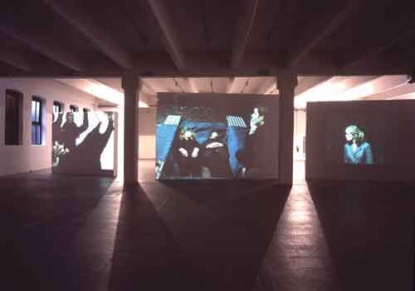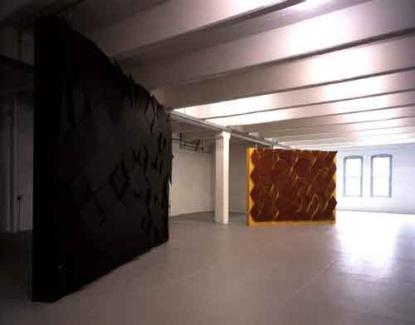Feature: Reviews
Rosemarie Trockel
- Rosemarie Trockel: Spleen
- Dia Center for the Arts, New York
- October 16, 2002 - June 15, 2003
reviewed by Laura Wolfram
Rosemarie Trockel, a German conceptual artist, describes herself as the “model” for the ideas she hopes to communicate. Of this role, she writes, A model is not straightforward, not so clear; it’s made out of circumstances, including your own perspective. Not surprisingly, Trockel’s art is anything but straightforward. Her videos and sculptures in Spleen, currently on view in Manhattan at the Dia Center for the Arts, confront viewers with enigmatic and often strangely abrupt narratives filled with bizarre metaphors and surreal plot sequences.
One of the few non-profit institutions in gallery-packed Chelsea, the Dia Center is dedicated to presenting site-specific installations. Each floor of the converted warehouse features one-person exhibitions of the work of internationally recognized contemporary artists. Born in Schwerte, Germany in 1952, Trockel studied painting at Cologne’s Werkkunstschule (School of Industrial Arts*) during the 1970s, a time when the school was heavily influenced by the work of WWII veteran Joseph Beuys. Using non-traditional materials, including his signature felt and fat, Beuys created artwork intended to provoke questions about what art is and to what extent cerebral processes can be said to be art. Trockel shares Beuys’ interest in asking questions through art; in fact, the pieces in Spleen often seem to ask far more questions than they answer. During the 1980s, Trockel’s medium of choice was wool, with which she produced “knitting pictures” composed of swaths of machine-knitted wool patterned with computer-generated geometric motifs or, occasionally, political logos such as the Soviet hammer and sickle. Trockel’s playful imposition of “masculine” industrial methods on knitting, a traditionally feminine and domestic occupation earned her a reputation as a feminist artist. She began showing works at Monica Sprüth’s Cologne gallery (formerly known as Galerie Philemene Magers), which at the time showed work by female artists only.
Trockel’s works in other mediums often recall the themes of feminine versus masculine and domestic versus industrial. For instance, an untitled 1991 sculpture now in Cologne’s Ludwig Museum consists of a block of steel fitted with six hot plates in parallel lines. Her 1999 retrospective at London’s Whitechapel Art Gallery included what the critic Rachel Withers derisively described as, “a veritable orgy of eggs.” For this spectacle, Trockel filled a certain area of the gallery with egg-themed works: egg wallpaper, eggshells strung together like beads, photographs of whipped egg whites, a deluxe hen-house, and so on. Her use of the extremely delicate egg as a flexible, durable medium subtly expresses her interest in pushing simple, natural materials such as wool through complicated industrial processes.
Though Trockel has often been associated with feminism and women’s issues, she has produced little overtly activist art. Instead, she merely toys with the connotations of political movements. For instance, a 1986 knitted picture shows a hammer and sickle against a background of red and white stripes reminiscent of the American flag. This composition employs two powerful political symbols, yet it does not provide viewers with any meaningful message about the relationship between the United States and the USSR. Trockel’s art rarely answers; instead, it shocks viewers into formulating questions. For instance, viewers of the knitting pictures are gently nudged into wondering why the imposition of “masculine” machinery on the “feminine” art of knitting should surprise them, and what their surprise or amusement indicates about their preconceptions of masculine and feminine roles.
The videos and sculptures included in Spleen, though produced between 2000 and 2002, are no less enigmatic than Trockel’s earlier artwork. Stories remain unfinished, and questions remained unanswered. The exhibition is organized around five videos projected on walls whose obverses are faced with steel and aluminum plates. These videos center on Trockel’s understanding of the spleen as the originator of human emotions and passions. While Baudelaire, to whose gloomy poem “Spleen” Trockel’s title most likely refers, saw the spleen as the source of despair, depression, and disgust with life, Trockel interprets it as the source of all emotions: sorrow, anger, joy, mirth, and curiosity. By filming a young woman named Manu in various situations, Trockel explores a range of human emotions under different circumstances.
In Manu’s Spleen 1, Manu and two friends stroll through a cemetery. Upon finding a male corpse lying in a freshly-dug open grave, the trio pauses, and Manu jumps down into the grave, lies down next to the corpse, and plays dead while her friends casually chat and smoke cigarettes. After a five-minute interval during which Manu appears just as dead as the corpse, her Ophelian blond hair strewn limply around her pale face, she comes back to life just as suddenly as she “died.” Apparently having tired of death, Manu climbs out of the grave. She and her friends stroll out of the graveyard as nonchalantly as they entered it. Though Western cultural conventions dictate that this encounter with mortality should be construed as frightening or grisly, Manu and her friends appear to view it as a mere curiosity. Manu sees the corpse, ingenuously wonders what it feels like to lie in an open grave, and decides to give it a try. Neither she nor her friends evince any sense of having broken a cultural taboo; they are simply satisfying a casual yet at the same time profoundly human curiosity about death.
Directly to the left of the graveyard video, Manu’s Spleen 3 (2001) depicts an equally human act: laughter. In this video, a rowdy group of friends crowd around a pregnant Manu at her baby shower. Champagne glass in hand, Manu leans forward and blows out the candles on her cake. As she straightens up and inhales, her swollen belly deflates with a sudden pop, as if a balloon had burst. At the sight of her vanished pregnancy, Manu’s friends begin to laugh hysterically, sounding more like hyenas than human partygoers. The hand-held camera circles the room drunkenly, mimicking the inebriated dizziness of this riotous crowd of women. After less than a minute, the video loops back to the pregnant Manu, who once again blows out her candles, straightens up, and pops. The soundtrack for this entire sequence is Madonna’s “Don’t Tell Me” played backwards, adding to the sense of chaos and disorientation. Metaphorically, Manu has given birth to collective mania and unbridled mirth.
Manu’s Spleen 2 (2002) presents a stark contrast to the pregnant/non-pregnant Manu’s manic energy. Here a silent and expressionless Manu stands next to a speaker at a demonstration against the proposed demolition of two of Cologne’s cultural institutions: the Kunsthalle and the Kunstverein. The speaker, played by actor Udo Kier, addresses a small crowd of half-interested listeners, pleading earnestly for them to help save the two museums. Shot in black and white with a shaky handheld camera and poor-quality sound recording equipment, the video seems deceptively ancient, as if it had been shot years ago, rather than during the spring of 2002. Whereas other Spleen videos make explicit the emotional content of the artwork, Manu’s Spleen 2 seems oddly devoid of passion. Kier’s listeners appear unresponsive, Manu stares blankly ahead, and it is only Kier who betrays any emotion, as he hyperbolically speaks of the buildings as having been “sentenced to death.” The speaker is the only splenetic element in the composition; the rest of the figures, Manu included, seem mere props.
The sculptures included in the exhibition are, if possible, even more enigmatic than the videos. In most cases, their link to the concept of spleen is unclear. While titles such as Blackboard Jungle and No Woman No Cry are suggestive of some kind of emotion, the works themselves are neutral and geometric: formally interesting, but emotionally blank. The exception, perhaps, is Phobia, a 2002 sculpture made from five rectangular strips of aluminum with black cotton trimming. The strips are laid parallel to one another along a wall, jutting out at irregular angles. Their surface has been polished to a mirror sheen, so that the sculpture reflects the gallery and its visitors. Thanks to the angles at which the metal strips are placed, a viewer standing squarely in front of Phobia sees his or her body separated into five strips, the head at the far right of the work, and the lower body on the far left. Phobia thus acts upon its viewers, slicing them into the same number of pieces that Trockel herself sliced the aluminum into when designing this work. In presenting the gallery-goer with a mutilated view of him or herself, Phobia cleverly projects a somewhat disturbing emotional content onto its own viewer.
Phobia aside, most of the sculptures in the gallery seem out of place at an exhibition that claims to focus on the source of human emotions and passions. In addition, it is not always clear how certain videos relate to the concept of spleen. To her credit, however, Trockel, never promises clarity; in fact, she explicitly states that her ideas will rarely be straightforward.
Rosemarie Trockel: Spleen is on view at Dia Center for the Arts, 548 West 22nd Street (between 10th & 11th Ave.), New York, NY. Gallery hours are Wednesday-Sunday noon-6pm. Admission $6, students & seniors $3, children under 10 and members, free. For more information call (212) 989-5566 or visit www.diacenter.org.


